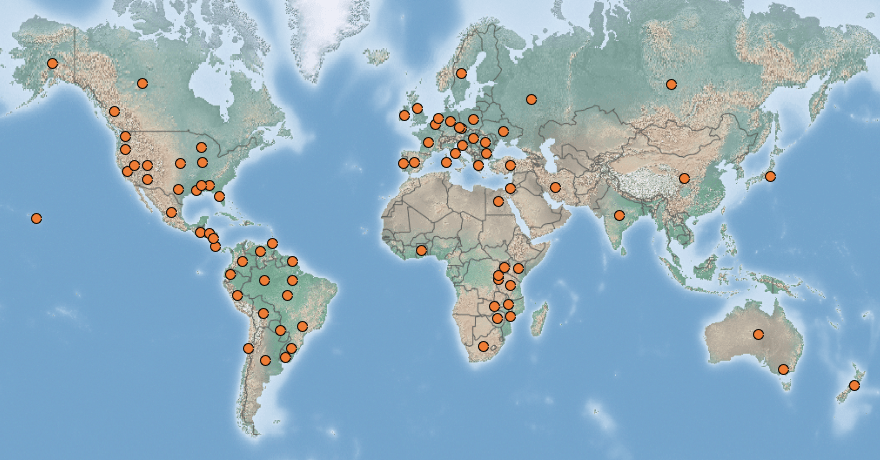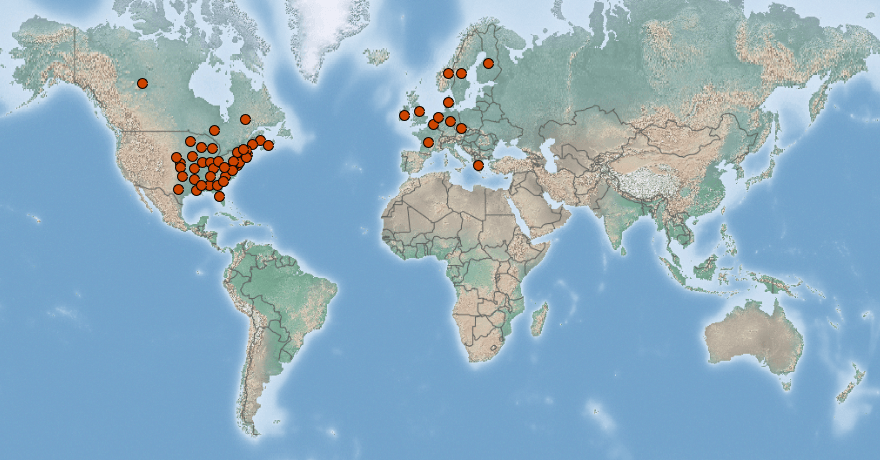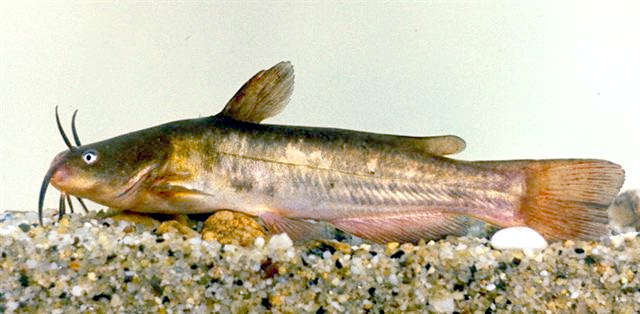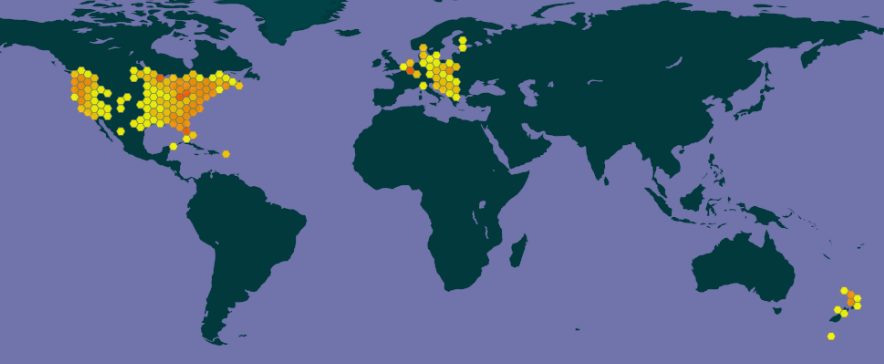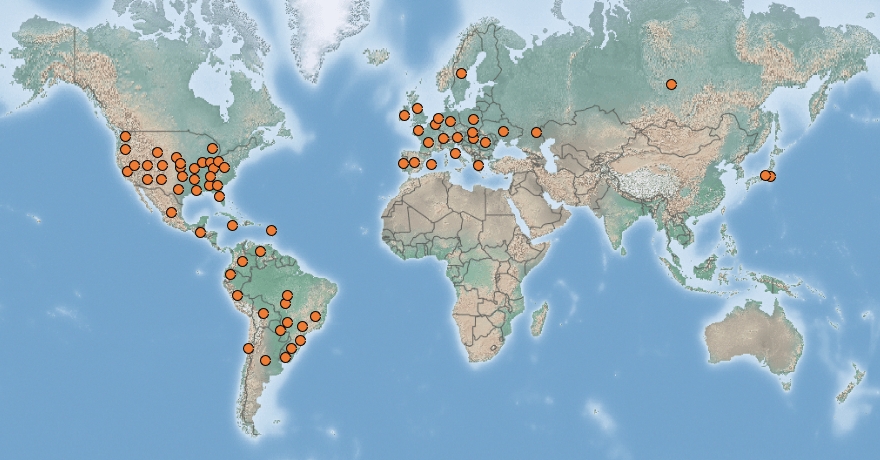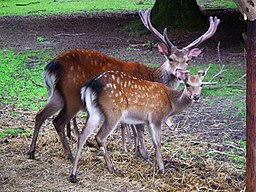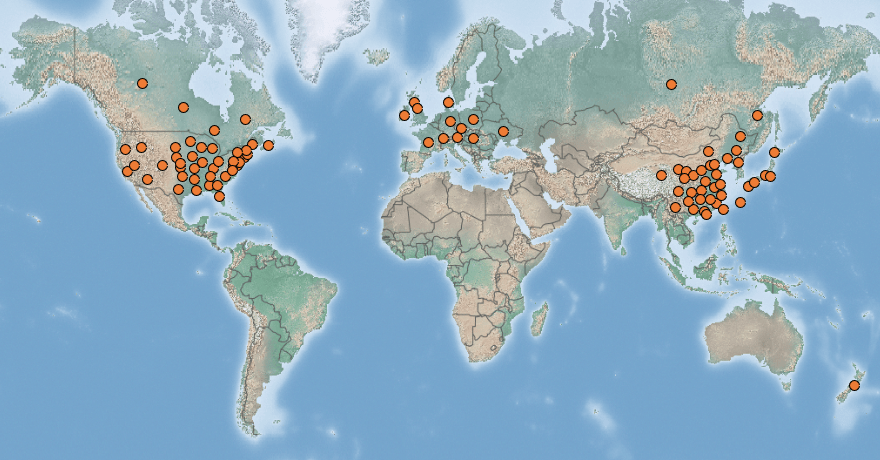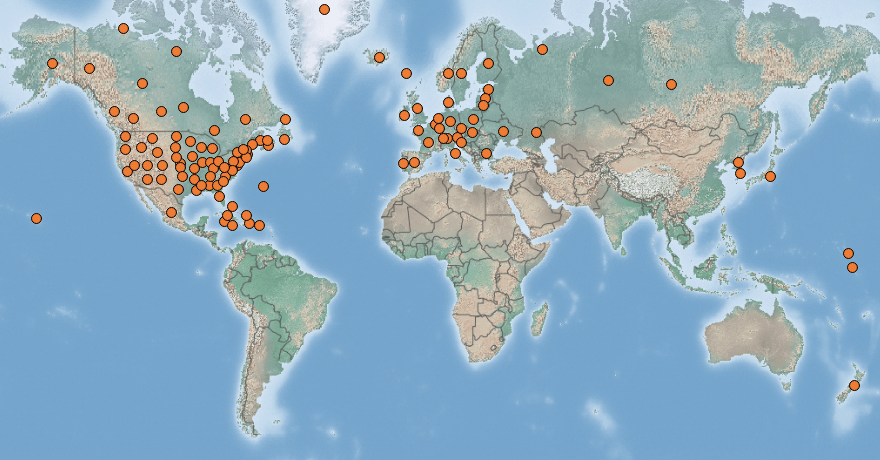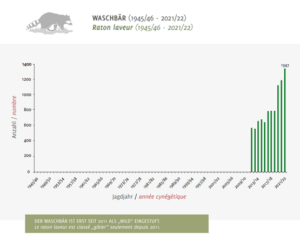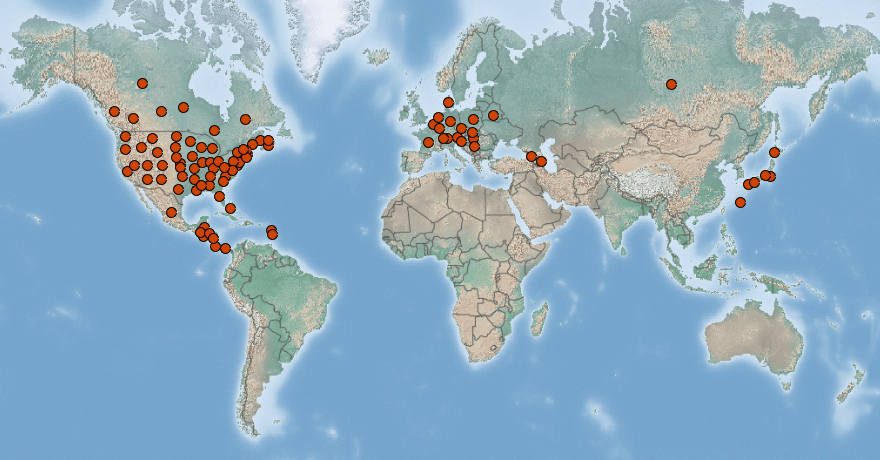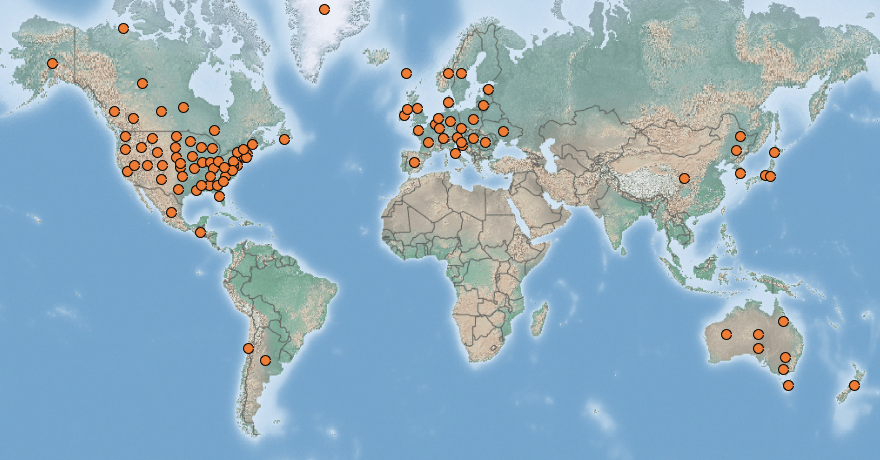 |
Tree of heaven |
Status LU: established. 1st record: LU <1875, ITW <2013. |
 |
Himmelsbam |
Status Eur.: established. 1st record: HU 1740s. IAS of EU concern (2019). |
 |
Ailante glanduleux |
RA: ISEIA: C1. Harmonia+: 0,42. |
 |
Götterbaum |
Wikipedia:     Wikispecies: Wikispecies:  | CABI | CABI |
 |
Hemelboom |
Back to the list of neophytes |
Brief description
Ailanthus altissima (Mill.) Swingle is a fast-growing, light-demanding and thermophilic pioneer tree species. It grows best on nutrient-rich soils and is very tolerant to dryness and air pollution. It is mostly found in waste and disturbed areas, but can also invade different kinds of forest ecosystems, riparian areas, rock outcrops and semi-natural grasslands. Winged seeds are easily dispersed by wind and water over distances exceeding several hundreds of metres (Branquart et al. 2017).
Ailanthus altissima successfully displace native vegetation due to its rapid growth and root suckering. It produces allergenic toxins in bark and leaves. As these accumulate in the soil, they inhibit the growth of other plants (allelopathic interactions), favour the formation of monospecific stands and inhibit vegetation succession. Ailanthus also increases soil N content and pH. Ailanthus can reduce soil water availability in case of severe infestation. It may damage roads and other infrastructures due to strong and rapid root development (Branquart et al. 2017). The root system is aggressive enough to cause damage to sewers and foundations (GISD 2019).
Photo gallery
Alley of Alianthus altissima, Porte de France, Belval, Esch-sur-Alzette. Photos by Yan Steil, 23rd July 2014.
IAS of Union concern
In 2019, Ailanthus altissima was added to the list of invasive alien species of Union concern (Anonymous 2019) which implies that member states shall take all necessary steps to prevent it’s unintentional introduction or spread.
Status and distribution in Luxembourg
The oldest reference to Ailanthus altissima in Luxembourg is found in the flora of Krombach (1875: 108) who lists it as a cultivated species. To mention an old example, Jean Feltgen (1833-1904) included a specimen from a garden in Diekirch in his herbarium, unfortunately without mentioning a date (Specimen № 15467, MNHNL 2000-). It can still be considered the first documented record of the species before 1905, within Jean Feltgen’s lifetime.
The first documentation of the tree of Heaven in the wild dates from 2013, when Jerry Grün reports a grown specimen in a forest edge near Elvange (Ries & Krippel 2021). An earlier report on 13 July 1993 by Léopold Reichling in the Pfaffenthal district in Luxembourg City could not be verified as in the wild as it might have been part of the plantations in the gardens of the Hospice du Pfaffenthal (Obs. key: LUXNATFUND431045, MNHNL 2000-).
According to Lambinon & Verloove (2012: 463) the species is quite rare in urban areas (AR) and very rare in rural areas in the territory of the flora.
Ailanthus altissima is found in several parks in the country, including Tony Neuman Park (Hollman & Schroeder 1997: 22) and municipal park in Luxembourg City.
For two decades the species did not appear to have spread to the wild. It is only in recent years that the species was planted in several urban areas and appeared in the wild on sandstone cliffs in Luxembourg City (cf. also Krippel et al. 2020: 32).
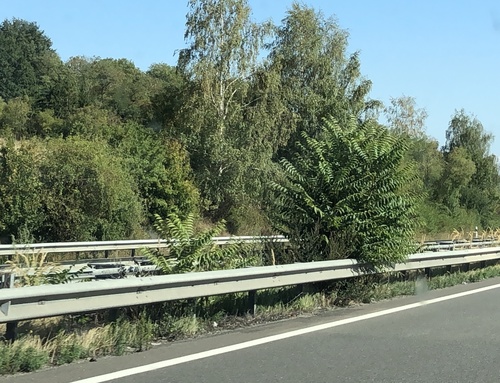
In the median strip of Highway A1 near the port of Mertert. Photo: © Yves Krippel, 20200907,
In 2020, the salt-tolerant Ailanthus altissima was detected for the first time in a motorway median strip (A1 motorway near the port of Mertert, Yves Krippel, 2020-09-07, iNaturalist).
Considering the recent expansion of the species in Luxembourg and its probable future increased spread due to climate change, and to avoid major problems urban areas experience with the tree of Heaven as a weed across Europe, Ailanthus should not be planted any more as an ornamental tree and existing populations should be eradicated.
An identification sheet of the species has been published by the MECDD in French and German.
Ailanthus as ornamental tree in urban areas
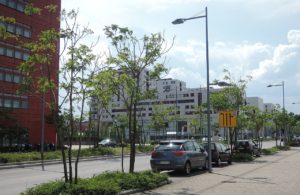
Alley of Alianthus altissima, Porte de France, Belval, Esch-sur-Alzette. Photo: Yan Steil, 23.07.2014.
- On 23rd July 2014 a complete alley of Ailanthus altissima was discovered in the street Porte de France in Belval / Esch-sur-Alzette. It was recently planted in the course of the regeneration of the brownfield site into a large scientific and cultural centre, including the science faculty of the University of Luxembourg (Steil 2014, pers. comm.). Based on sattelite photos the alley counts more than 70 individuals.
- A group of Ailanthus altissima trees was recently planted behind the Olympic swimming pool in the Kirchberg disctrict of Luxembourg City by the Fonds du Kirchberg. Seedlings have already started to spread on this site (Helminger 2018, pers. comm.).
- A row of 9 Ailanthus altissima was planted before 2008 along a parking area behind the church of Walferdange (Welter et al. 2008: 81; map).
- A single tree is present in the section of the municipal park situated between Avenue de la Porte-Neuve and Avenue Émile-Reuter in Luxembourg City (on the side of the Avenue de la Porte-Neuve in line with two trees of Corylus colurna. Two single trees can be found in the Rue du Rollingergrund, one in front of the house n°294 and another next to the residence on n°306 (Welter et al. 2008: 81).
- A single old tree with several saplings and a single younger grown-up tree were observed on 10th June 2018 in the municipal park of Diekirch situated along the river Sûre.
- A group of 4 Ailanthus altissima trees grow in a roundabout on the N6 road north of Mersch and several seedlings / young plants have been found in the commercial zone east of the roundabout (Yves Krippel, pers. comm. 2020-10-27).
In a few decades, with climate change helping, Ailanthus might grow in many pavement rinds, flowerbeds and vague grounds all over these sites and possibly into the wild in adjacent areas, as illustrated in the following example from planted tree in a roundabout north of Mersch:
Ailanthus in the wild
In 2018, three populations of Ailanthus altissima were sighted in the wild in Luxembourg City:
- on the edge of the cliff along the railway to Wasserbillig between the Plateau du Rham and the INS. As part of a site visit on 28/11/2019 with representatives of the Nature and Forestry Administration, Public Buildings and the MNHNL, it was decided that the management of this site will take place during winter 2019-2020 and that management should be continued until the site no longer represents a danger to the railway line below.
- on the edge of the Plateau du Rham southeast of the former military canteen;
- on the sandstone cliffs above n°11 Bisserweg (Grund district, Luxembourg City).
Management
A recent study in Berlin concludes that urban management strategies concerning Ailanthus would gain support from citizens when combining multiple approaches (Kowarik et al. 2021): (i) to control the species in case of realized negative impacts; (ii) to prevent the invasion of the species in areas of conservation concern; and (iii) to develop novel approaches of integrating wild Ailanthus trees into urban green spaces. These insights could support management measures that need to be established due to the EU-Regulation on Invasive Alien Species.
Action plan
The action plan dedicated to the tree of heaven, designed to limit the spread and minimise its in Luxembourg, was drafted in 2020 (Pfeiffenschneider & Hoppe 2020) and submitted for a 60 days lasting public consultation on 9 September 2020. It clearly postulates that, if its population continues to increase, this species is likely to cause ecological and economic damage.
Risk assessment
ISEIA protocol
C1 (1+1+1+1) (Ries et al. 2013: 18).
Harmonia+ protocol
Overall risk score 0,42 = (Overall Invasion score 0,74 x Overall Impact score 0,57) (Ries et al. 2020).
0,74


Invasion
0,57


Impact
0,42


Risk
Worldwide distribution

CABI 2014: https://www.cabi.org/isc/datasheet/3889#toDistributionMaps
Bibliography
- Anonymous, 2019. Commission implementing regulation (EU) 2019/1262 of 25 July 2019 amending Implementing Regulation (EU) 2016/1141 to update the list of invasive alien species of Union concern. Official Journal of the European Union L 199/1-2 (26.7.2019).
- Branquart, E., S. Vanderhoeven, W. Van Landuyt, F. Van Rossum & F. Verloove, 2017. Harmonia database: Ailanthus altissima (Mill.) Swingle. Harmonia version 1.2, Belgian Forum on Invasive Species. URL: http://ias.biodiversity.be [accessed on 2019-10-23]
- CABI, 2014. Ailanthus altissima (Mill.) Swingle [original text by Soraya Constán Nava]. In: Invasive Species Compendium. Wallingford, UK: CAB International. URL: www.cabi.org/isc [accessed 2019-11-26]
- GISD, 2019. Species profile: Ailanthus altissima in the Global Invasive Species Database. URL: http://www.iucngisd.org/gisd/speciesname/Ailanthus+altissima [accessed 2019-11-28]
- Hollman, A. & M. Schroeder, 1997. Parc Tony Neuman (Joyaux botanique au centre de la ville de Luxembourg, réalisé à partir de 1948 par Me Tony Neuman, notaire, Henri Luja, architecte-urbaniste, et Alphonse Hollman, jardinier en chef). AAT-Info 53, supplément. Éd. AAT – Garten und Teichfreunde Luxemburgs. Imprimerie Saint-Paul, Luxembourg. 64 pp.
- Kowarik I., T.M. Straka, M. Lehmann, R. Studnitzky & L.K. Fischer, 2021. Between approval and disapproval: Citizens’ views on the invasive tree Ailanthus altissima and its management. NeoBiota 66: 1–30. https://doi.org/10.3897/neobiota.66.63460
- Krippel, Y., T. Helminger & G. Colling, 2020. Notes floristiques. Observations faites au Luxembourg (2018-2019). Bulletin Soc. Nat. luxemb. 122 : 29-55. [PDF 132 KB]
- Krombach, J.-H.-G., 1875. Flore du grand-duché de Luxembourg. Plantes phanérogames. 564 p. Luxembourg, Imprimerie Joris.
- Lambinon J. & F. Verloove, 2012. Nouvelle flore de la Belgique, du grand-duché de Luxembourg, du Nord de la France et des régions voisines. Sixième édition. Avec la collaboration de L. Delvosalle, B. Toussaint, D. Geerinck, I. Hoste, F. Van Rossum, B. Cornier, R. Schumacker, A. Vanderpoorten et H. Vannerom. Jardin botanique national de Belgique, Meise. CXXXIX + 1195 pp. ISBN : 9789072619884.
- MNHNL, 2000-. Ailanthus altissima in Recorder-Lux, database on the natural heritage of the Grand Duchy of Luxembourg. Musée national d’histoire naturelle, Luxembourg. URL: https://mdata.mnhn.lu [Accessed 2018-01-08]
- Pfeiffenschneider, M. & Hoppe, F., 2020. Plan d’action pour espèces exotiques envahissantes au grand-duché de Luxembourg : Faux-vernis du Japon, Ailanthus altissima (Mill.) Swingle. Version 3.0 – 2020/09/20. Administration de la nature et des forêts, Luxembourg. 19 pp.
- Ries C. & Y. Krippel 2020. Ailanthus altissima (Mill.) Swingle – Distribution actuelle, recensement futur et mise en oeuvre des mesures d’éradication au grand-duché de Luxembourg. Rapport au Groupe de coordination sur les espèces exotiques envahissantes au Luxembourg (MECDD), Version 1.1 (2020-11-24). 9p.
- Ries, C. & Y. Krippel, 2021. First records of 56 invasive alien vascular plants in Luxembourg. Bulletin de la Société des naturalistes luxembourgeois 123: 115-127. [PDF 241 KB]
- Ries, C., Y. Krippel & M. Pfeiffenschneider, 2020. Risk assessment after the Harmonia+ protocol of invasive alien vascular plant species in Luxembourg. Bull. Soc. Nat. luxemb. 122: 197-205. [PDF 132 KB]
- Ries, C., Y. Krippel, M. Pfeiffenschneider & S. Schneider, 2013. Environmental impact assessment and black, watch and alert list classification after the ISEIA Protocol of non-native vascular plant species in Luxembourg. Bull. Soc. Nat. luxemb. 114: 15-21. [PDF 652 KB]
- Welter A., J.Turk & J. Trossen, 2008. Les arbres introduits au Luxembourg. Inventaire des essences arborescentes non indigènes de pleine terre présentes sur le territoire du Grand-Duché de Luxembourg. Ferrantia 53, Musée national d’histoire naturelle, Luxembourg, ISSN 1682-5519, 111 pp.
Page content last updated on 2023-08-17. Last proofread by Caroline Grounds on 2019-11-12.






 Invasion
Invasion
 Impact
Impact
 Risk
Risk
